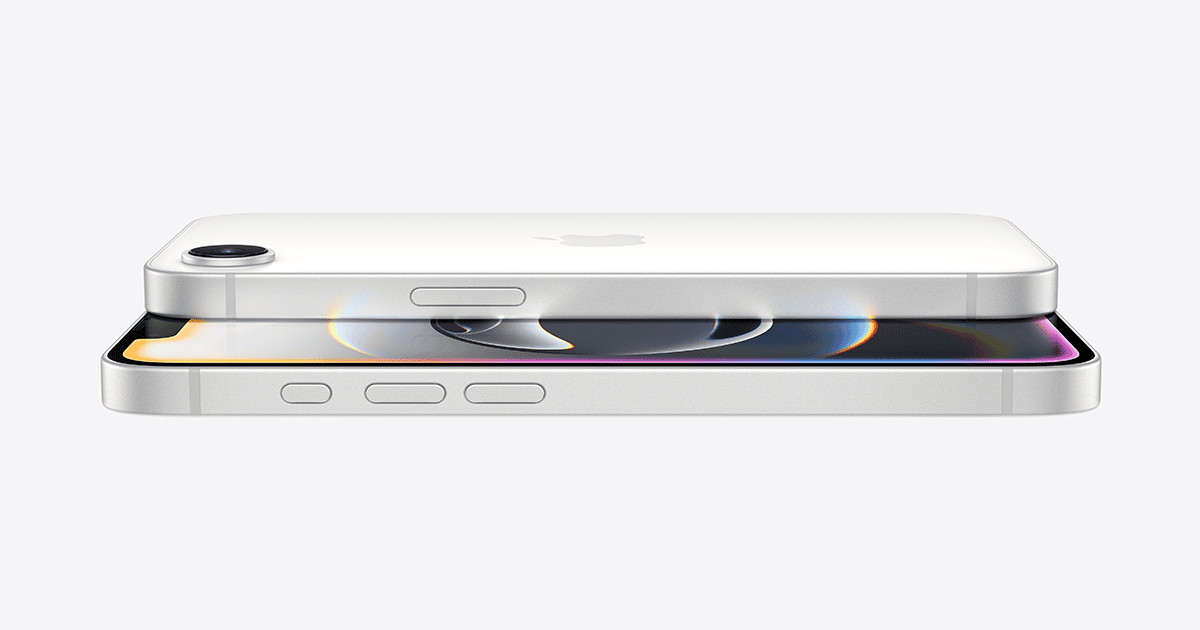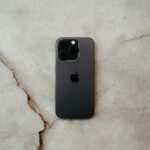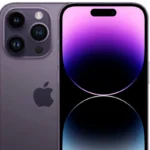Apple’s new iPhone 16e is quietly redefining what a budget iPhone looks like. Priced at $599, it’s now the most affordable way into the iPhone 16 lineup — effectively replacing the iPhone SE while leapfrogging it in design, power, and usability. But while it looks like a win for value-conscious consumers, there’s a growing concern that this price won’t survive much longer.
A Budget iPhone That Actually Feels Premium
The iPhone 16e was released on February 28, 2025, and it has quickly become one of the best value propositions in the smartphone market. Priced at $599, it offers flagship-level performance, a modern design, and Apple Intelligence support, all without the hefty cost of a premium phone.
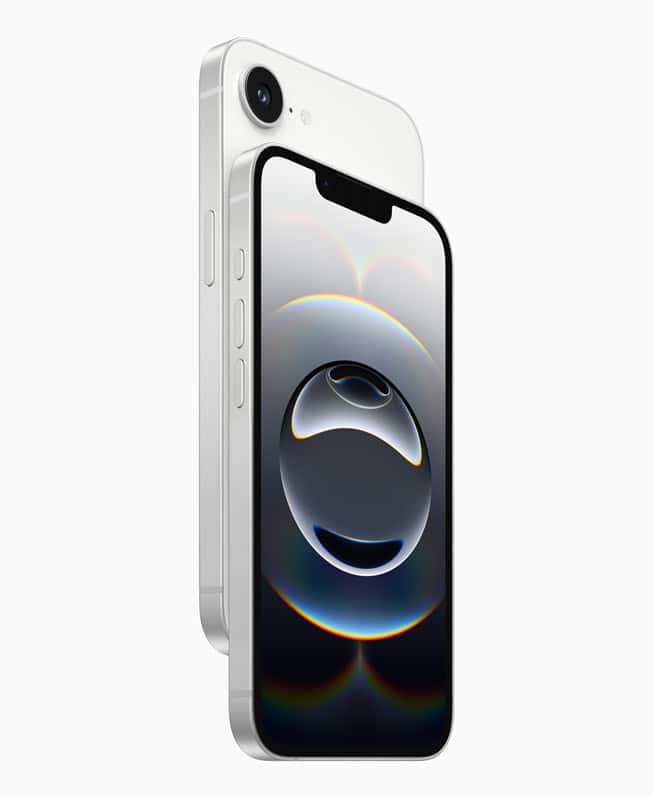
However, it’s important to note that this price may not last much longer. Multiple factors could influence the price of the 16e including higher costs from the tariffs that would likely be passed on to the customer and the possibility that this device has been cannibalizing more of Apple’s sales than they previously predicted. Given that the 16e is at least $200+ less than any other modern iPhone, it has been a huge seller since its launch.
If you’ve been considering the 16e as a secondary phone, a gift, or your primary device, now might be the time to act. A combination of factors such as tariffs, changes in production lines, and rising component costs could lead to an increase in the price of the $599 iPhone by summer. What price could we see? Most analysts predict that the iPhone 16e could go as high as $799 – $899.
What Makes the iPhone 16e So Good?
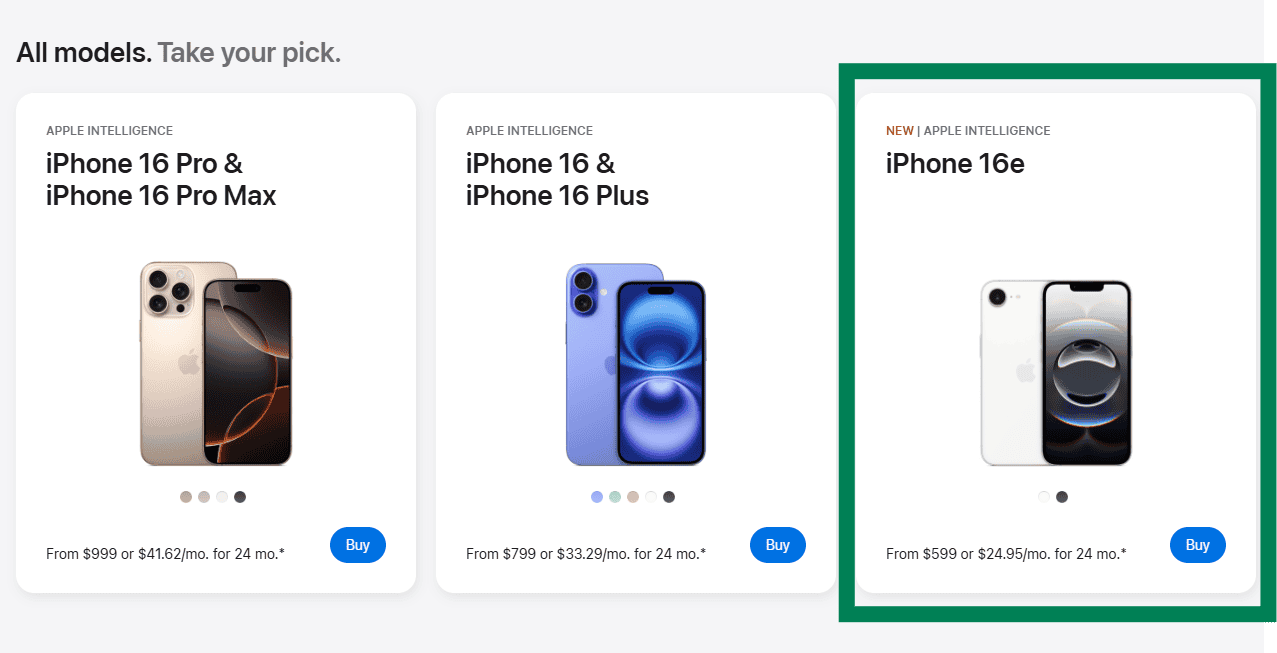
Let’s be clear: the 16e isn’t a “cheap” phone. It’s an affordable one — and there’s a difference. This model shares much of the DNA of its higher-end siblings, offering:
- A18 Chip – The same powerful processor found in the standard iPhone 16
- Apple C1 Modem – Better connectivity and battery efficiency
- 48MP Main Camera – A huge leap from past base models
- Apple Intelligence support – On-device AI for smarter productivity
- A Clean, Modern Design – Slim bezels, lightweight feel, and available in multiple colors
You’re getting a full-fledged iPhone experience that’s more than fast enough for gaming, photo editing, video calls, and future iOS updates — for under $600.
Why The Price Is in Danger
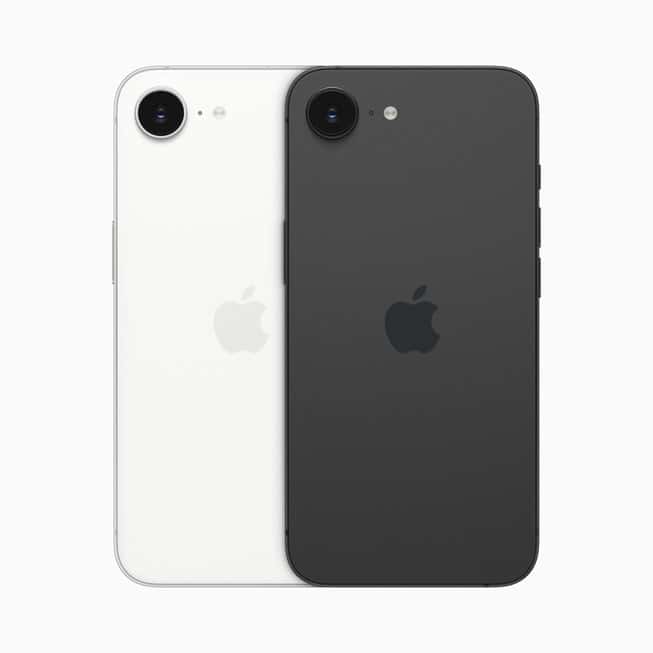
Here’s the reality: Apple is under pressure from new U.S. tariffs that could massively increase the cost of importing electronics — especially those produced in China and Southeast Asia. The iPhone 16e, like most Apple devices, isn’t made in the U.S. And while Apple has worked to diversify its manufacturing footprint, nearly every country they’ve shifted to is getting hit with new tariffs.
Some of the new proposed tariff rates:
- India: 26%
- Vietnam: 46%
- Thailand: 37%
- Malaysia: 24%
- China: Total impact 54%
Even iPhones made in India — Apple’s new production darling — will now be subject to steep tariffs when imported to the U.S. Apple has been stockpiling inventory ahead of the changes, but once that supply dries up, new pricing models are almost inevitable.
Apple Hasn’t Raised Base iPhone Prices Since 2017… Until Now?
Since the launch of the iPhone X, Apple has maintained the same $999 price point for its base Pro models in the U.S., even through COVID, inflation, and global chip shortages. But this time is different. These tariffs are hitting everything in Apple’s pipeline — not just China. They apply to iPhones, AirPods, iPads, and Macs being made across Asia.
And while Apple might absorb a fraction of the cost and negotiate with suppliers behind the scenes, there’s no way they can eat a 30–50% manufacturing increase forever — especially on their most affordable product.
If you’re wondering whether this $599 deal will return later in the year, history suggests it won’t.
The Psychology of Price Increases
Once prices go up, they usually don’t come back down. That’s not just speculation — it’s market behavior. During the pandemic, companies across industries raised prices and discovered that most consumers still paid. So they left the prices high.
Apple has played this game before in international markets. iPhone prices rose in Japan and Europe due to currency shifts and inflation — and they stayed elevated. U.S. customers have been spared… until now.
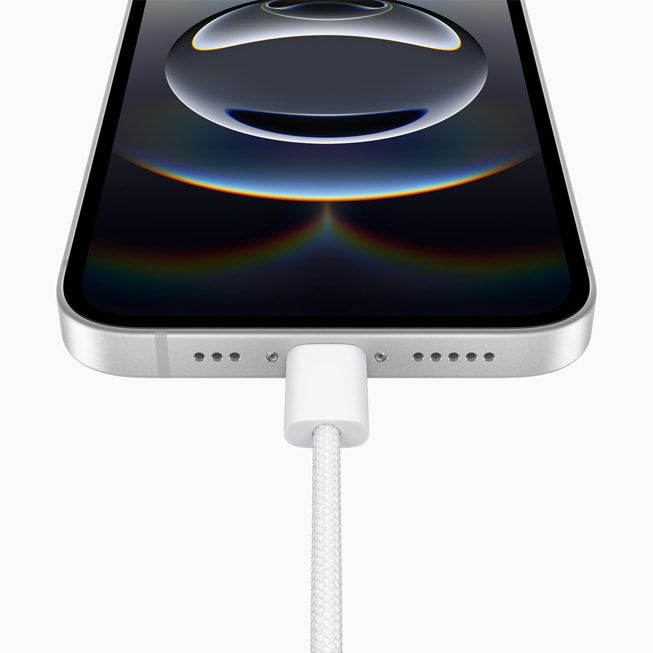
Should You Wait for the iPhone 17?
If you’re hoping the iPhone 17 will offer something drastically better at a similar price, don’t count on it. Leaks suggest minor design tweaks, slightly better cameras, and perhaps a new “iPhone Air” model — but nothing revolutionary in the entry-tier space.
Even worse: if the tariff situation worsens or becomes permanent, Apple may adjust the pricing ladder across the board. That could push the 17 series up and out of reach for many buyers.
The Bottom Line: Grab It While You Can
The iPhone 16e at $599 is a rare sweet spot in the Apple lineup — affordable, capable, and future-ready. But economic pressure is building. Once that $599 tag disappears, don’t expect it to bounce back.
If you’re in the market for a new iPhone and don’t want to overpay later, this is the deal to jump on — before it vanishes for good.
Key Takeaways
- The iPhone 16e offers a modern full-screen design and improved performance at $599, positioning it as Apple’s new entry-level iPhone.
- The 48-megapixel camera delivers quality photos in most situations, though it lacks the ultrawide lens found on higher-end models.
- Battery performance sits between the standard iPhone models and the longer-lasting Plus and Pro Max variants, providing adequate daily use for most users.
Design and Build Quality
The iPhone 16e represents a significant design evolution from its predecessor, the iPhone SE, adopting a more modern aesthetic while maintaining a budget-friendly price point of $599. The device brings premium elements to Apple’s entry-level offering with its edge-to-edge display and sleek profile.
Aesthetic Appeal and Form Factor
The iPhone 16e features a contemporary edge-to-edge design that aligns more closely with Apple’s flagship models than with the outdated design of the retired iPhone SE. This modernization eliminates the thick bezels and home button that characterized previous budget iPhones, creating a more immersive visual experience.
The device is notably lightweight, making it comfortable to hold for extended periods. This reduced weight doesn’t compromise the premium feel but instead enhances the overall user experience by preventing hand fatigue during lengthy usage sessions.
The iPhone 16e incorporates Dynamic Island, a feature previously reserved for higher-end models. This interactive notch area replaces the traditional notch design, providing users with contextual information and controls that adapt based on current activities.
Durability and Materials
Apple has balanced cost considerations with build quality in the iPhone 16e. The device features a glass front and back panel, facilitating wireless charging while maintaining a premium look and feel. The frame construction uses aluminum rather than the stainless steel found in Pro models, which contributes to its lighter weight.
The iPhone 16e supports MagSafe technology, enabling magnetic attachment of accessories and efficient wireless charging. This feature, previously unavailable in the budget iPhone category, significantly enhances the device’s ecosystem compatibility.
The display represents a major upgrade with its OLED panel, delivering deeper blacks and more vibrant colors than the LCD screen of the iPhone SE. This improvement in screen technology dramatically enhances content consumption, whether for everyday use or media viewing.
Comparison to iPhone 15 and iPhone 16
The iPhone 16e bridges the gap between budget and flagship iPhones. While sharing the edge-to-edge design philosophy with the iPhone 16, it makes strategic compromises to achieve its lower price point. The device is visually more similar to current generation iPhones than to the dated iPhone SE design.
When compared to the standard iPhone 16, the 16e maintains many premium design elements while being $200 less expensive. The aesthetic differences between the two are subtle enough that most casual observers wouldn’t immediately identify the 16e as a budget option.
The inclusion of Dynamic Island gives the 16e a feature parity with more expensive models in the lineup, eliminating one of the most visible distinctions between budget and premium iPhones. This helps users feel they’re getting a modern iPhone experience despite the lower price.
Display Technology
The iPhone 16e features Apple’s Super Retina XDR OLED display technology, bringing premium screen quality to this budget-friendly model. The display delivers vibrant colors and excellent contrast while maintaining the familiar notch design for Face ID.
OLED Display Characteristics
The Super Retina XDR OLED display in the iPhone 16e represents a significant upgrade from previous budget iPhone models. This technology provides true blacks and vibrant colors that make content appear more lifelike and engaging. The display supports a wide color gamut (P3) and uses Apple’s True Tone technology, which automatically adjusts the screen’s white balance based on ambient lighting conditions.
Unlike LCD displays found in older budget iPhones, the OLED panel in the 16e offers superior contrast ratios and energy efficiency. Images appear sharper, and videos show more detail in dark scenes. HDR content is particularly impressive, with brighter highlights and more shadow detail.
One design element that distinguishes the 16e from premium models is the return of the notch. While the iPhone 16 Pro uses the Dynamic Island, the 16e maintains the traditional notch design.
Screen Size and Resolution
The iPhone 16e features a 6.1-inch display, matching the standard iPhone 16 in size. This screen size offers a good balance between usability and portability, making the device comfortable to hold and operate with one hand.
The resolution comes in at 2,532 by 1,170 pixels, slightly lower than the standard iPhone 16’s 2,556 by 1,170 pixels. This minor difference is barely noticeable in everyday use. The pixel density remains high enough to make individual pixels indistinguishable at normal viewing distances.
For comparison:
- iPhone 16e: 2,532 × 1,170 pixels
- iPhone 16: 2,556 × 1,170 pixels
Screen brightness is adequate for outdoor use, though it doesn’t reach the peak brightness levels of the Pro models. Text appears crisp and readable even in bright conditions, making the 16e suitable for productivity tasks like email and document editing.
Performance
The iPhone 16e delivers impressive performance metrics thanks to Apple’s latest chip architecture and connectivity innovations. The device maintains the power users expect from Apple while offering it at a more accessible price point.
A18 Chip Capabilities
The iPhone 16e comes equipped with the same A18 chip found in the standard iPhone 16 and iPhone 16 Plus models. This 6-core CPU configuration includes two high-performance cores that enable the device to handle demanding tasks with ease. In benchmark tests, the iPhone 16e scored 3,441 on single-core and 8,362 on multi-core Geekbench tests, demonstrating its processing prowess.
The A18 chip represents a significant upgrade over previous entry-level iPhones. It not only delivers faster day-to-day performance but also supports Apple Intelligence features that require advanced computational capabilities. Users will notice smoother app launching, faster photo processing, and improved multitasking compared to older models.
Apple has optimized the chip for both performance and efficiency, allowing the iPhone 16e to maintain speed while preserving battery life.
GPU and Graphic Performance
The graphics performance of the iPhone 16e shows notable improvements over previous entry-level iPhones. The A18 chip includes an enhanced GPU that handles graphically intensive applications and games with minimal lag or stuttering.
In gaming scenarios, the iPhone 16e maintains stable frame rates even with visually demanding titles. The device supports higher graphic settings that were previously limited to premium iPhone models.
Video editing and AR applications also benefit from the improved GPU. Users can edit 4K video clips with less rendering time and experience more fluid augmented reality experiences.
The thermal management system has been refined as well, allowing for sustained performance during extended gaming sessions without significant throttling or uncomfortable device heating.
5G and Wi-Fi Connectivity
The iPhone 16e features Apple’s new C1 modem chip, marking a significant advancement in cellular connectivity. This custom-designed modem improves 5G performance with faster download and upload speeds while being more power-efficient than previous models.
The C1 modem provides better signal reception in challenging environments and supports a wider range of 5G bands for improved global compatibility. Users will experience more reliable connections and fewer dropouts during calls or data-heavy tasks.
On the Wi-Fi front, the iPhone 16e supports the latest Wi-Fi standards, ensuring fast and stable wireless connections at home or in public networks. The enhanced antenna design contributes to better overall wireless performance with improved range and signal strength.
Network-dependent applications like video streaming, online gaming, and video calls benefit from these connectivity improvements, providing a smoother experience with less buffering and latency.
Camera Systems
The iPhone 16e offers a streamlined camera experience with its single rear shooter and front-facing TrueDepth camera. Apple has implemented computational photography techniques to compensate for the lack of an ultrawide lens found in competitors and higher-end iPhone models.
Main Camera Features
The iPhone 16e features a single 48-megapixel main camera with an f/1.6 aperture, which Apple markets as their “Fusion camera.” This sensor combines pixels to improve light gathering capabilities, resulting in 24-megapixel still images that maintain excellent quality even in challenging lighting conditions.
Despite lacking an ultrawide lens that many competitors include (such as the Pixel 8a), Apple employs computational photography to expand the camera’s versatility. This approach allows Apple to advertise what they call a “2-in-1” camera system, though this primarily refers to software enhancements rather than physical lenses.
The main camera delivers impressive results in most everyday shooting scenarios. Colors appear natural, and details remain sharp across various lighting conditions. Dynamic range is particularly notable, preserving details in both highlights and shadows.
Video Recording Capabilities
The iPhone 16e supports 4K video recording at various frame rates, maintaining the high-quality video performance iPhones are known for. Video stabilization works effectively to smooth out hand movements during recording.
Users can capture crisp, detailed footage that rivals what’s possible on more expensive smartphones. The A18 chip powers advanced video processing capabilities, ensuring smooth recording and playback.
Low-light video performance shows improvement over previous budget iPhone models. Audio recording quality remains excellent with clear voice capture and good ambient sound reproduction.
The front-facing TrueDepth camera also supports 4K video recording, making it suitable for vlogging and high-quality video calls. Cinematic mode allows users to create videos with shallow depth of field effects, automatically shifting focus between subjects.
Photographic Styles and Portrait Mode
The iPhone 16e includes Apple’s Photographic Styles feature, allowing users to customize the look of their photos with preset options that adjust tone and warmth while preserving skin tones. These styles can be applied while shooting rather than as post-processing filters.
Portrait Mode works well on the 16e despite having only a single rear lens. The A18 chip handles depth mapping through computational photography, creating convincing background blur effects in most scenarios.
Edge detection has improved over previous single-camera iPhones, with more accurate subject separation from backgrounds. Portrait Lighting effects add studio-quality lighting effects to portrait shots, enhancing facial features through various presets.
The TrueDepth front camera also supports Portrait mode, making selfies with professional-looking depth effects easily achievable. Users can adjust the depth effect before and after taking photos for maximum flexibility.
Battery Life and Charging
The iPhone 16e impresses with its battery performance, outshining previous models in its size category. Apple has made significant improvements to both battery capacity and charging technologies, delivering what they claim is “the best battery life of any 6.1-inch iPhone.”
Battery Capacity and Usage Time
According to multiple reviews, Apple’s claim about the iPhone 16e’s battery life is not an exaggeration. The device outperforms even the standard iPhone 16 in battery tests, providing longer usage time between charges. This improvement comes partially from Apple’s new custom C1 modem, which operates more efficiently than previous components.
The C1 chip introduces new energy efficiency that significantly extends usage time. Battery optimization is particularly noticeable during everyday tasks like streaming, browsing, and using applications.
Real-world testing confirms that users can expect all-day battery life under normal usage conditions. The iPhone 16e maintains consistent performance even with moderate to heavy usage throughout the day.
Charging Options and Speeds
The iPhone 16e supports various charging methods to accommodate different user preferences. Wired charging remains the fastest option, though specific charging speeds haven’t changed dramatically from previous generations.
Apple continues to use the Lightning port for the 16e rather than transitioning to USB-C as seen in some higher-end models. This maintains compatibility with existing Lightning cables and accessories that users may already own.
Fast charging capabilities allow the device to reach approximately 50% battery in 30 minutes when using compatible power adapters. However, users should note that Apple doesn’t include a power adapter in the box, only providing a charging cable.
Wireless Charging Technologies
The iPhone 16e supports standard Qi wireless charging, making it compatible with a wide range of third-party wireless chargers available on the market. This provides users with flexibility in choosing charging accessories.
MagSafe compatibility enables more efficient wireless charging through magnetic alignment. The magnetic connection ensures optimal positioning for faster and more reliable charging speeds compared to standard wireless charging methods.
MagSafe also opens up an ecosystem of accessories beyond just charging, including cases, wallets, and mounts that attach securely to the back of the phone. Charging speeds through MagSafe can reach up to 15W, which is faster than the standard Qi wireless charging supported by the device.
Energy transfer efficiency has improved according to some reviews, meaning less power is wasted during the charging process.
Software and Ecosystem
The iPhone 16e delivers a software experience nearly identical to its premium siblings while serving as an affordable entry point to Apple’s ecosystem. It runs the same iOS version and features as the standard iPhone 16, providing users with a consistent experience across devices without compromising on functionality.
iOS Version and Features
The iPhone 16e ships with iOS 18.3, offering the full suite of features available on more expensive models. Users upgrading from older iPhone SE models will notice significant interface changes and new functionality.
The software experience between the iPhone 16e and iPhone 16 shows virtually no differences, making the more affordable device an excellent value proposition. All core iOS features work smoothly, including Control Center customizations, Focus modes, and App Library organization.
Apple hasn’t officially stated how long the iPhone 16e will receive software updates, but based on Apple’s track record, users can expect at least 5-6 years of iOS updates. This long-term software support represents one of the strongest selling points compared to similarly-priced Android alternatives.
Siri and Artificial Intelligence
The iPhone 16e supports the latest version of Siri with improved voice recognition and faster response times. The digital assistant handles basic tasks efficiently – setting timers, sending messages, and answering simple questions.
Some AI-powered features include:
- Text suggestions in Messages and Mail
- Smart photo organization in the Photos app
- Intelligent search across the device
- Voice-to-text dictation with improved accuracy
While the iPhone 16e includes these core AI capabilities, it lacks some of the more advanced Apple Intelligence features found in premium models. The device’s processor handles day-to-day AI tasks without noticeable lag or performance issues.
Apple Services Integration
The iPhone 16e serves as an ideal gateway into Apple’s service ecosystem. It seamlessly integrates with Apple Music, Apple TV+, iCloud, and Apple Arcade subscriptions.
FaceTime video calls work flawlessly on the device, with the front camera providing clear video even in challenging lighting conditions. The integration with Messages allows for seamless transitioning between text conversations and video calls.
Find My functionality works identically to other iPhone models, letting users locate their devices, AirTags, and compatible accessories on a map. The feature also enables precise location sharing with family and friends.
iCloud backup and sync features ensure data remains consistent across multiple Apple devices. For new Apple users, the iPhone 16e offers a complete ecosystem experience without requiring investment in the most expensive hardware.
Security and Privacy
The iPhone 16e carries forward Apple’s commitment to user security while introducing several refinements to privacy features. Security remains a cornerstone of the iPhone experience, with the 16e offering robust protection mechanisms that safeguard user data without compromising convenience.
Face ID Technology
Face ID on the iPhone 16e represents a significant upgrade from the Touch ID system found on the older iPhone SE. This facial recognition technology uses advanced depth-sensing capabilities to create a detailed map of the user’s face. The system works effectively in various lighting conditions, including complete darkness.
Apple has improved the Face ID algorithm in the iPhone 16e, making it faster and more responsive than earlier implementations. The technology can recognize users even when wearing most masks and sunglasses, a welcome enhancement for everyday usability.
Face ID data never leaves the device and remains encrypted within the Secure Enclave, a dedicated security processor isolated from the main system. This approach ensures biometric information stays protected even if other parts of the phone are compromised.
Data Protection and Encryption
The iPhone 16e employs hardware-level encryption that secures all data stored on the device. Every file, photo, and message is encrypted automatically, with decryption only possible using the user’s passcode or biometric authentication.
Apple’s implementation of end-to-end encryption extends to iMessage and FaceTime communications, ensuring that only intended recipients can access content. Neither Apple nor third parties can intercept or read these encrypted messages.
App permissions on the iPhone 16e provide granular control over what information each application can access. The system displays clear privacy indicators when an app uses the microphone or camera, adding transparency to how personal data is being utilized.
The built-in Mail Privacy Protection feature helps prevent senders from tracking email opens and masks the user’s IP address, adding another layer of privacy protection.
Emergency and Health Features
The iPhone 16e includes Emergency SOS capabilities that allow users to quickly contact emergency services by pressing the side button five times. This feature automatically shares the user’s location with emergency responders, potentially saving critical time during urgent situations.
Apple’s Medical ID function stores essential health information that can be accessed even when the phone is locked. This feature could prove life-saving by providing first responders with crucial details about allergies, medications, and emergency contacts.
Crash Detection technology uses the device’s sensors to identify severe car accidents and automatically initiates emergency calls if the user is unresponsive. This automated safety feature works silently in the background until needed.
The Find My network helps locate a lost iPhone 16e while maintaining privacy through end-to-end encryption. Even Apple cannot determine the device’s location during this process, demonstrating the company’s privacy-first approach.
Connectivity Features
The iPhone 16e brings significant advancements in connectivity through Apple’s new C1 modem and modern connection standards. Connectivity options include 5G, Wi-Fi 6, Bluetooth 5.3, and the now-standard USB-C port.
5G And Wi-Fi Performance
The iPhone 16e marks Apple’s debut of its in-house C1 modem, signaling the company’s shift away from Qualcomm components. This new modem delivers reliable 5G performance in both sub-6GHz and mmWave bands. In testing across various network conditions, the C1 modem showed comparable speeds to previous models but with improved signal retention in challenging coverage areas.
Wi-Fi 6 support provides faster wireless connections with compatible routers. The iPhone 16e showed download speeds up to 1.2 Gbps in optimal conditions, though real-world performance typically averages 400-600 Mbps. This represents a modest improvement over previous budget iPhone models.
Bluetooth 5.3 connectivity offers stable connections with wireless earbuds and speakers, with an effective range of about 30 feet through walls.
USB-C and Future Connectivity
The iPhone 16e adopts USB-C, replacing the Lightning port found on older models. This USB-C port supports data transfer speeds up to 480 Mbps (USB 2.0 standard) – significantly slower than the iPhone 16 Pro’s USB 3.0 implementation but adequate for most users.
The port supports reverse charging, allowing the iPhone 16e to power accessories like AirPods. Unlike premium models, however, the 16e doesn’t support video output through USB-C.
The move to USB-C aligns with EU regulations and simplifies the charging ecosystem for users with multiple devices. Most users will appreciate needing just one cable for their iPhone, iPad, and MacBook.
eSIM technology is fully supported, reducing the need for physical SIM cards. The iPhone 16e can store multiple eSIM profiles, making it convenient for travelers or users with separate work and personal numbers.
Pricing and Value Proposition
The iPhone 16e enters the market at $599, positioning itself as Apple’s new entry-level option in the iPhone 16 lineup. This price point creates interesting considerations for potential buyers comparing it with older models or contemplating an upgrade.
Comparison with iPhone SE Models
The iPhone 16e represents a significant shift in Apple’s budget iPhone strategy, offering considerably more value than previous iPhone SE models. While priced higher than the iPhone SE (2022)’s $429 starting price, the 16e delivers substantial improvements that justify the $170 premium.
The 16e features a larger, more modern display without a home button, Face ID technology, significantly better cameras, and access to Apple Intelligence features. Battery life is particularly impressive, with Apple claiming up to 6 hours longer usage than iPhone 11 and 12 hours more than the iPhone SE.
For budget-conscious buyers, the value equation is compelling when considering the 16e’s flagship-level processor and longer software support timeline. The iPhone 16e effectively bridges the gap between budget and premium models, offering 90% of the flagship experience at 60% of the flagship price.
Upgrade Considerations for iPhone X and iPhone 14 Users
For iPhone X-era users, the 16e presents a compelling upgrade path with its modern design, significantly faster A18 processor, and access to the latest iOS features including Apple Intelligence. The improved camera system and battery life alone make it worth considering.
iPhone 14 users, however, face a less clear-cut decision. While the 16e offers the newer A18 chip versus the 14’s A15, the performance differences in everyday use are minimal. Camera capabilities remain similar, though the 16e might offer slightly better low-light performance.
The $599 price tag sits awkwardly between the discounted iPhone 15 (now often available for $699 or less) and refurbished iPhone 14 models (around $500). For many iPhone 14 users, waiting another year or saving for the standard iPhone 16 might provide better value unless Apple Intelligence features are particularly important.
Accessibility and Additional Features
The iPhone 16e incorporates several accessibility enhancements while adding unique features that cater to users with diverse needs. Apple has made significant improvements to make the device more inclusive and functional for all users.
Action Button Utilization
The iPhone 16e introduces the Action Button, previously only available on Pro models. This customizable button replaces the traditional mute switch and can be programmed to perform various functions. Users can set it to launch the camera, activate flashlight, open Voice Memos, trigger Shortcuts, or access accessibility features.
The Action Button’s versatility makes the phone more user-friendly. It responds with haptic feedback to confirm activations. For photography enthusiasts, it can function as a physical shutter button.
Setting up the Action Button is straightforward through the Settings app. Apple has made this process intuitive with a visual menu showing all available options. The button’s responsiveness is excellent, requiring just enough pressure to prevent accidental triggers.
Special Features for Visual and Hearing Impairments
The iPhone 16e comes equipped with robust accessibility options for users with visual or hearing challenges. VoiceOver has been enhanced with more natural-sounding voices and improved responsiveness when navigating apps. The Magnifier app uses the camera to help users read small text and identify objects.
For hearing-impaired users, Live Captions generate real-time transcriptions for phone calls, FaceTime, and video content. The feature works offline for privacy. Sound Recognition alerts users to important noises like sirens or doorbells.
Visual Intelligence allows users to point their camera at objects for identification and information. This feature is particularly useful for visually impaired users navigating unfamiliar environments. Genmoji, powered by Apple Intelligence, creates custom emojis from simple text descriptions, adding another dimension to expression for users with different communication preferences.
Final Thoughts on the iPhone 16e
The iPhone 16e represents Apple’s new entry point into the iPhone 16 lineup at $599, filling the gap between the discontinued iPhone SE and the standard iPhone 16. This strategic positioning makes premium iPhone features more accessible without breaking the bank.
Performance is impressive, with benchmark tests showing the iPhone 16e actually outscoring the standard iPhone 16 in CPU tests. This makes it an excellent value proposition for users who want Apple’s latest technology at a more reasonable price point.
Camera capabilities are solid but limited. The phone features a 48-megapixel main sensor that produces quality images in most lighting conditions. However, buyers should note the absence of an ultrawide camera, which may disappoint photography enthusiasts.
Design-wise, the 16e maintains the sleek aesthetic of the iPhone 16 family. Apple hasn’t compromised on build quality despite the lower price tag, making this device feel premium in hand.
Battery life and overall performance make the iPhone 16e one of the best budget smartphones available today. The price jump from the previous iPhone SE ($429) to the 16e ($599) is substantial, but the technological improvements justify the increase for most users.
For consumers seeking an affordable entry into Apple’s ecosystem or those upgrading from much older iPhone models, the 16e offers tremendous value. It strikes an impressive balance between performance, features, and price that few competitors can match in the mid-range smartphone market.
Frequently Asked Questions
The iPhone 16e brings several significant improvements over previous models while maintaining Apple’s commitment to quality at a more accessible price point. Users have many questions about specific features and capabilities before making their purchase decision.
What improvements have been made to the camera system in the iPhone 16e compared to its predecessor?
The iPhone 16e features a single camera system that has sparked considerable discussion among reviewers. While competitors like the Pixel 8a offer multiple cameras, Apple has focused on improving the quality of its single lens.
The main camera has been upgraded with a larger sensor that captures more light, resulting in better low-light performance. Apple has also enhanced the computational photography capabilities, leveraging the device’s processing power to deliver improved image quality.
Despite having only one camera, the iPhone 16e produces remarkably detailed photos with accurate colors and good dynamic range. Portrait mode has been refined to create more natural background blur even without a dedicated depth sensor.
How does the iPhone 16e’s battery life perform under heavy usage?
Battery life on the iPhone 16e has seen notable improvements, with reviewers specifically mentioning “excellent battery life” as a key strength. The efficiency gains come from both hardware and software optimizations.
The device easily lasts a full day of moderate to heavy use. Users can expect 6-7 hours of screen time with mixed usage including social media, video streaming, and web browsing.
Apple’s power management system works effectively to minimize battery drain during standby periods. The iPhone 16e also supports fast charging, allowing users to quickly top up when needed.
Can the iPhone 16e’s display quality stand up to that of its high-end competitors?
The 6.1-inch display on the iPhone 16e has received positive feedback from reviewers. One review specifically mentioned that “even the most discerning reviewer will have a hard time complaining about the iPhone 16e’s 6.1-inch display.”
The screen offers excellent brightness levels, making it usable even in bright outdoor conditions. Color accuracy is exceptional, with vibrant yet realistic tones that enhance the viewing experience.
While it doesn’t match the premium displays on Apple’s Pro models in terms of refresh rate or resolution, the quality is more than sufficient for everyday use. The display size feels appropriate for 2025 standards and offers a good balance between screen real estate and one-handed usability.
What are the notable advancements in the processing power of the iPhone 16e?
The iPhone 16e is powered by Apple’s custom processor that delivers impressive performance. Reviewers note that it has “great performance” with only a minimal reduction in GPU cores compared to higher-end models.
Day-to-day tasks like app switching, web browsing, and social media use feel smooth and responsive. The processor handles multitasking efficiently, allowing users to switch between apps without noticeable lag.
Gaming performance remains strong despite having one less GPU core than premium models. Most modern games run well at medium to high settings without performance issues.
The phone also supports Apple Intelligence features, bringing AI capabilities to this more affordable model. This positions the iPhone 16e as a future-proof device that will benefit from upcoming AI-powered features.
How does the storage capacity options for the iPhone 16e vary and what is suitable for average users?
The iPhone 16e offers multiple storage configurations to accommodate different user needs and budgets. Storage options start at 128GB for the base model, providing enough space for essential apps and a moderate collection of photos.
The mid-tier 256GB option offers the best balance of capacity and value for most users. This configuration provides ample room for photos, videos, apps, and games without requiring frequent content management.
For users who capture lots of high-resolution photos or 4K videos, the 512GB model provides substantial storage headroom. However, this premium option comes with a significant price increase that may not be justified for average users.
Cloud storage integration with iCloud helps extend the effective storage capacity by offloading older or less frequently accessed content.
What are the new or improved features in the iPhone 16e’s operating system and user interface?
The iPhone 16e runs the latest version of iOS, bringing numerous refinements to the user experience. The interface maintains Apple’s signature clean design while introducing subtle improvements to navigation and functionality.
One notable new feature is satellite texting capability, which one reviewer mentioned being prompted to use when opening the Messages app. This allows communication in areas without cellular coverage, enhancing the phone’s utility in remote locations.
The device includes advanced privacy controls that give users more granular management of their data. App permissions are clearly presented, making it easier to understand and limit what information apps can access.
The iPhone 16e also features Apple’s custom C1 modem for efficient 5G connectivity, ensuring fast and reliable mobile data performance. This represents Apple’s move toward developing more components in-house rather than relying on third-party suppliers.

